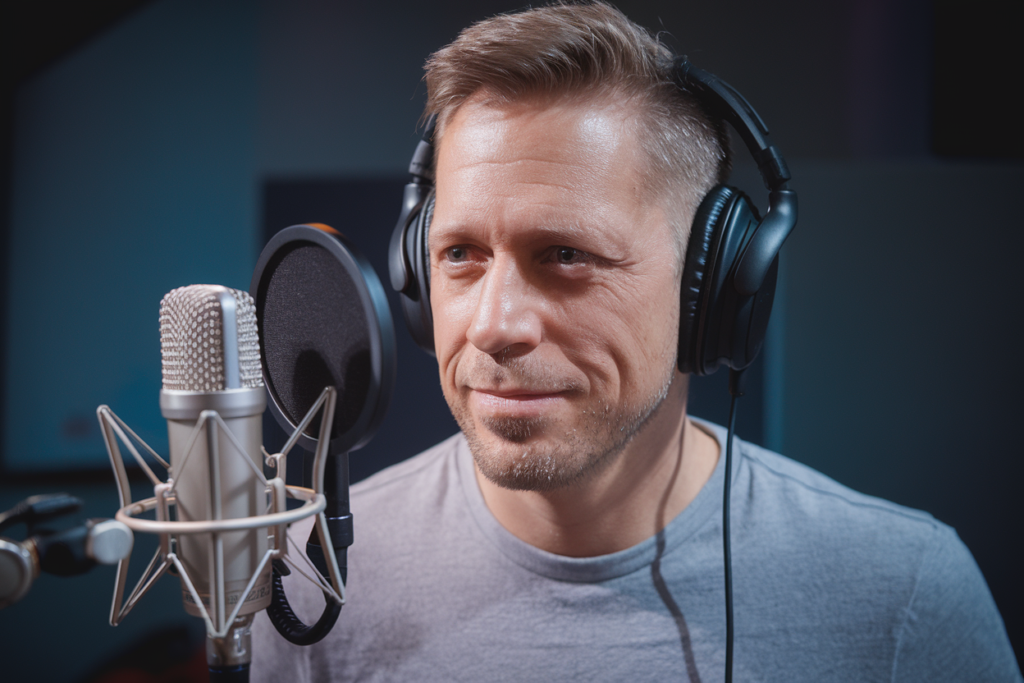Key Takeaways
- Importance of Voiceovers: Voiceovers enhance storytelling in various media, shaping audience perceptions and emotional connections through skilled vocal delivery.
- Cultural Context Matters: Understanding the preferences of German and English-speaking audiences is crucial for selecting appropriate voice talent that resonates with cultural nuances.
- Dubbing vs. Subtitling: Dubbing provides an immersive experience by synchronizing voices with on-screen characters, while subtitling maintains original audio for authenticity but may distract viewers.
- Performance Styles: German voice artists focus on nuanced, restrained performances emphasizing sincerity, whereas English-speaking voice talent often embraces a wider range of dynamic styles to engage diverse audiences.
- Quality and Reception: Audiences in Germany value authentic, emotionally resonant performances; in contrast, English-speaking markets appreciate versatility and regional variations in voice work.
- Translation Challenges: Linguistic differences and cultural references pose unique challenges in voiceover translation, necessitating skilled voice actors who can adapt scripts while preserving meaning and impact.
Ever wondered how German and English voiceovers stack up against each other? As the demand for high-quality voice work rises, understanding these differences can make or break your project. Whether you’re localizing a video game or dubbing a film, knowing what to expect from each language’s voiceover talent is crucial.
Overview of Voiceovers
Voiceovers play a crucial role in bringing various media to life, from films and commercials to video games and e-learning modules. Understanding voiceovers means recognizing the talent behind the voice and how it can enhance your projects.
Definition of Voiceovers
A voiceover refers to the production technique where a voice is recorded for use in different media without appearing on screen. This art form involves skilled voice artists or actors who convey emotions, characters, and narratives through their vocal delivery. Whether it’s a soothing narrator guiding viewers through a documentary or an energetic character in an animated series, each voiceover adds depth and personality.
Importance of Voiceovers in Media
Voiceovers are essential for engaging audiences effectively. They help shape perceptions, evoke feelings, and create connections with viewers. In advertising, compelling voiceover talent can influence purchasing decisions by establishing brand identity and trustworthiness. In film dubbing or localization projects, matching the original tone ensures that cultural nuances resonate with new audiences.
Utilizing professional voice over talent enhances storytelling by providing clarity in communication. Different styles suit various genres; for instance, dramatic tones work well in thrillers while friendly voices fit family-oriented content perfectly. Overall, quality voice work elevates any project’s impact by making it memorable and relatable.
Cultural Context
Cultural context plays a significant role in shaping voiceover preferences and practices. Understanding these differences can enhance your project’s effectiveness, whether for video games or films.
Voiceover Preferences in Germany
Germany values authenticity and emotional depth in voiceovers. German audiences often prefer natural-sounding voices that convey sincerity. The choice of voice talent is critical; it reflects cultural nuances and regional accents. For instance, a strong, authoritative voice might fit a documentary, while a softer tone could suit an animated feature. Additionally, the practice of “lip-sync dubbing” dominates German film adaptations, ensuring that the voice matches the on-screen dialogue closely, which enhances immersion for viewers.
Voiceover Preferences in English-Speaking Countries
In English-speaking countries like the US and UK, there’s a broader range of styles and tones accepted in voiceovers. Audiences tend to appreciate versatility among voice artists. You might find playful tones in commercials or intense deliveries in movie trailers. Moreover, different regions within these countries have unique preferences; for example, British audiences may favor understated performances while American listeners often enjoy more exaggerated characterizations. In general, the emphasis lies on engaging storytelling where the right voice over talent brings characters to life seamlessly across various media formats.
Understanding these cultural contexts helps you choose suitable voice actors for your projects, ensuring they resonate with specific audiences effectively.
Techniques Used in Voiceovers
Voiceovers play a crucial role in media production, utilizing various techniques to enhance storytelling and audience engagement. Understanding these techniques can help you choose the right approach for your projects.
Dubbing vs. Subtitling
Dubbing involves replacing the original audio of a film or video with a new voice track in another language. This technique requires skilled voice actors who match their performances to the on-screen characters, ensuring synchronized lip movements and emotional expression. In contrast, subtitling retains the original audio while displaying translations on screen. This method allows viewers to hear the authentic voices of actors but may require them to read quickly, which can distract from visuals. Each approach has its benefits; dubbing provides an immersive experience, while subtitling preserves authenticity.
Performance Styles and Delivery
Performance styles significantly influence how voiceovers resonate with audiences. German voice artists often focus on delivering nuanced, emotional performances that reflect sincerity and depth. They emphasize clear articulation and natural intonations that align with cultural expectations. English-speaking voice talent tends to explore a wider range of styles—from casual conversational tones to dramatic characterizations—catering to diverse audience preferences.
Delivery also varies between languages; German productions typically favor restraint over exaggerated expressions, while English projects may embrace more dynamic vocal variations for impact. Choosing the right performance style ensures your message connects effectively with your target audience, enhancing overall project quality.
Quality and Effectiveness
Quality and effectiveness in voiceovers play a crucial role in audience engagement. Understanding how different cultures perceive voice work can shape project success.
Audience Reception in Germany
In Germany, audiences appreciate authenticity and emotional resonance. They favor voice artists who deliver natural-sounding performances that convey sincerity. This preference for depth often leads to the use of skilled voice actors who excel in lip-sync dubbing, enhancing viewer immersion. When selecting voice talent for projects aimed at German audiences, matching the tone and style with cultural expectations is essential. A well-chosen German voiceover can elevate a narrative, making it relatable and impactful.
Audience Reception in English-Speaking Markets
English-speaking markets exhibit diverse preferences regarding voiceovers. Here, versatility among voice artists is highly valued; audiences enjoy varied styles ranging from understated British accents to more animated American characterizations. Selecting a suitable voice actor involves considering regional nuances—British listeners may lean towards subtlety while American viewers often respond positively to engaging performances with heightened emotion. Effective delivery by talented English-speaking voice over actors enhances storytelling, ensuring it resonates deeply with specific demographics.
Challenges in Voiceover Translation
Voiceover translation presents unique challenges, particularly when comparing German and English voiceovers. Understanding these hurdles ensures high-quality production that resonates with audiences.
Linguistic Nuances
Linguistic differences play a significant role in voiceover translation. Each language has its own rhythm, idioms, and expressions, which can affect how scripts are adapted. For example, German often employs compound words that may not have direct English equivalents. When translating for voice actors, it’s crucial to maintain the original meaning while ensuring the dialogue sounds natural in the target language. This requires skilled voice artists who excel at capturing subtleties and inflections specific to each language.
Moreover, pronunciation variations can also pose challenges. Certain sounds or phonemes exist in one language but not in another, making it essential for voice talent to adapt their delivery accordingly. A native speaker’s familiarity with these nuances enhances authenticity and engages listeners effectively.
Cultural References
Cultural references heavily influence how messages are perceived across different languages. In German voiceovers, humor and local idioms often reflect societal values and cultural norms. Translating these elements into English demands careful consideration so that they resonate with the intended audience without losing their impact.
Additionally, some phrases may carry cultural significance that doesn’t translate well; a direct translation could confuse listeners rather than connect with them emotionally. Skilled voice over talent understands these intricacies and knows how to modify content appropriately while preserving its essence.
By considering linguistic nuances and cultural references during the translation process, you ensure your project maintains its integrity across languages—enhancing viewer engagement while conveying your message clearly.
Conclusion
Understanding the differences between German and English voiceovers is key to achieving effective audience engagement. By appreciating the cultural nuances and preferences that shape these two markets, you can select the right voice talent for your projects.
Whether it’s the emotional depth favored in German voiceovers or the versatility celebrated in English-speaking markets, matching performance styles with audience expectations ensures a more impactful experience.
Navigating linguistic challenges also plays an essential role in maintaining authenticity across languages. With careful consideration of these factors, your voiceover projects can resonate deeper and create lasting impressions on viewers.
Frequently Asked Questions
What is a voiceover?
A voiceover is a recording technique where a voice is used in various media, such as films and commercials, without appearing on screen. It requires skilled voice artists to effectively convey emotions and narratives, enhancing storytelling and audience engagement.
How do German and English voiceovers differ?
German voiceovers emphasize authenticity and emotional depth, often using natural-sounding voices for sincerity. In contrast, English-speaking countries appreciate a wider range of styles, with British audiences favoring subtlety and American audiences enjoying more exaggerated performances.
Why is cultural context important in voiceovers?
Cultural context shapes audience preferences in both German and English-speaking markets. Understanding these nuances helps select appropriate voice talent that resonates with specific audiences, ensuring projects are relatable and impactful.
What are the differences between dubbing and subtitling?
Dubbing replaces original audio with a new language track using synchronized performances from voice actors. Subtitling retains original audio while displaying translations. Dubbing can enhance immersion but may lose some authenticity compared to subtitling.
What challenges arise in translating voiceovers between German and English?
Translating between German and English involves linguistic nuances like rhythm and idioms that may not directly translate. Cultural references also play a role; humor or local expressions must be adapted carefully to maintain emotional impact while preserving meaning.







